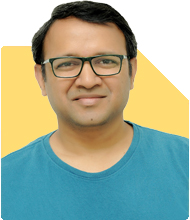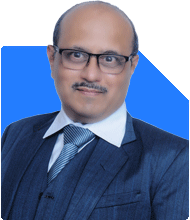Ramalingam Kalirajan |10894 Answers |Ask -Follow
Mutual Funds, Financial Planning Expert - Answered on Jul 10, 2024
He has an MBA in finance from the University of Madras and is a certified financial planner.
He is the director and chief financial planner at Holistic Investment, a Chennai-based firm that offers financial planning and wealth management advice.... more

Hi, I am 37 years old and my wife is 35 years. Self and wife jointly earn around 2.10 lakhs monthly and with expenses and EMIs amounting to 95k per month. We have MF value of Rs. 7.5 lacs, PF value of Rs. 10 lakhs. I want to retire around 50 years. Pls suggest suitable investment plan.
Understanding Your Financial Position
You have mutual funds worth Rs 7.5 lakhs and PF of Rs 10 lakhs. This is a strong start.
Monthly Savings Potential
Your monthly savings potential is Rs 1.15 lakhs. This can be directed towards various investments to build a substantial corpus by the time you are 50.
Setting Retirement Goals
You want to retire at 50, which gives you 13 years to build your retirement corpus. Let’s consider your retirement goals and lifestyle needs.
Children’s Education and Lifestyle Needs
If you have children, their education needs to be factored in. Assume average monthly expenses post-retirement are Rs 50,000. This translates to Rs 6 lakhs annually.
Building a Diversified Investment Portfolio
Mutual Funds
Mutual funds are a great way to grow your wealth. They offer diversification and professional management. Since you already have Rs 7.5 lakhs in mutual funds, let’s expand on this.
Advantages of Mutual Funds:
Professional Management: Experts manage your investments.
Diversification: Spreads risk across various assets.
Liquidity: Easy to buy and sell.
Compounding: Benefits of reinvesting returns over time.
Types of Mutual Funds:
Equity Funds: Invest in stocks, higher risk, higher returns.
Debt Funds: Invest in bonds, lower risk, stable returns.
Hybrid Funds: Mix of equity and debt, balanced risk and returns.
Systematic Investment Plan (SIP)
SIPs are a disciplined way to invest regularly. Investing a fixed amount monthly can average out market volatility. Considering your savings, an SIP of Rs 50,000 per month can be a good start.
Advantages of SIP:
Rupee Cost Averaging: Reduces impact of market volatility.
Discipline: Regular investing habit.
Flexibility: Can start with small amounts.
Public Provident Fund (PPF)
PPF is a safe, long-term investment with tax benefits. You already have Rs 10 lakhs in PF, which is great. Continue contributing to PPF for secure and tax-free returns.
Advantages of PPF:
Safety: Government-backed, risk-free.
Tax Benefits: Interest earned is tax-free.
Compounding: Long-term compounding benefits.
National Pension System (NPS)
NPS is a good option for retirement planning. It provides a mix of equity and debt exposure with tax benefits. You can invest a portion of your monthly savings in NPS for additional retirement security.
Advantages of NPS:
Tax Benefits: Additional tax deductions.
Diversification: Mix of equity and debt.
Retirement Focused: Designed for retirement planning.
Fixed Deposits (FDs)
FDs are safe, offering guaranteed returns. While returns are lower, they provide stability to your portfolio. Allocate a small portion to FDs for safety.
Advantages of FDs:
Safety: Guaranteed returns.
Liquidity: Can be easily liquidated.
Stability: Provides stability to your portfolio.
Gold Investments
Gold can be a good hedge against inflation. Consider a small allocation to gold, either through physical gold or gold ETFs.
Advantages of Gold:
Hedge Against Inflation: Protects against rising prices.
Tangible Asset: Physical gold is a real asset.
Liquidity: Easily tradable.
Disadvantages of Index Funds
You may come across index funds, which track market indices. While they offer low costs and simplicity, actively managed funds often outperform due to professional management. Index funds mirror the market and lack flexibility.
Benefits of Actively Managed Funds
Actively managed funds involve professional fund managers making investment decisions. They aim to outperform market indices, offering potential for higher returns.
Advantages of Actively Managed Funds:
Professional Expertise: Managed by experts.
Flexibility: Can adapt to market changes.
Potential for Higher Returns: Aim to outperform benchmarks.
Importance of Regular Funds
Regular funds involve a certified financial planner (CFP). They provide valuable advice and support, guiding your investments towards your goals. Direct funds lack this personalized touch.
Advantages of Regular Funds:
Expert Guidance: Get advice from a CFP.
Better Decision Making: Helps in making informed choices.
Personalized Service: Tailored to your needs.
Power of Compounding
Compounding is the process of earning returns on your returns. The longer you invest, the more you benefit. Starting early and investing regularly can significantly grow your wealth.
Benefits of Compounding:
Growth Over Time: Small investments grow significantly.
Reinvestment of Returns: Earn returns on returns.
Long-Term Wealth: Builds substantial wealth over time.
Reviewing and Adjusting Your Portfolio
Regularly review your investment portfolio. Adjust based on changing goals and market conditions. A diversified and balanced portfolio is key to long-term success.
Risk Management
Diversification helps manage risk. Don’t put all your money in one asset. Spread it across different investments to balance risk and returns.
Tax Planning
Plan your investments to maximize tax benefits. Use tax-saving instruments like PPF, NPS, and certain mutual funds. This reduces your taxable income and increases savings.
Emergency Fund
Maintain an emergency fund for unforeseen expenses. Ideally, save at least six months of expenses. This fund should be liquid and easily accessible.
Health and Life Insurance
Ensure you have adequate health and life insurance. This protects your family from financial strain in case of emergencies. Choose policies with sufficient coverage.
Estate Planning
Plan for the future by creating a will and estate plan. This ensures your assets are distributed as per your wishes. It also provides peace of mind for your family.
Genuine Compliments
You’ve done a great job managing your finances so far. Your disciplined approach is commendable. Planning for early retirement is a smart move.
Everyone has unique financial goals and comfort levels. It’s important to invest in what you’re comfortable with. Diversification helps balance safety and growth.
Your proactive approach towards financial planning is impressive. Continuously learning and adapting is key to financial success. Keep up the good work!
Final Insights
You have a solid financial base. Diversify your investments for balanced growth. Start planning for children’s education and retirement. Use a mix of mutual funds, PPF, NPS, and other safe investments. Regularly review and adjust your portfolio.
Your disciplined savings and investment strategy will help you achieve your retirement goals. With careful planning and diversification, you can secure a comfortable and financially stable future.
Best Regards,
K. Ramalingam, MBA, CFP,
Chief Financial Planner,
www.holisticinvestment.in
You may like to see similar questions and answers below
Ramalingam Kalirajan |10894 Answers |Ask -Follow
Mutual Funds, Financial Planning Expert - Answered on Jun 18, 2024
Ramalingam Kalirajan |10894 Answers |Ask -Follow
Mutual Funds, Financial Planning Expert - Answered on Jul 16, 2024
Milind Vadjikar | Answer |Ask -Follow
Insurance, Stocks, MF, PF Expert - Answered on Dec 19, 2024
Ramalingam Kalirajan |10894 Answers |Ask -Follow
Mutual Funds, Financial Planning Expert - Answered on Jul 09, 2025
Ramalingam Kalirajan |10894 Answers |Ask -Follow
Mutual Funds, Financial Planning Expert - Answered on Aug 18, 2025
Patrick Dsouza |1429 Answers |Ask -Follow
CAT, XAT, CMAT, CET Expert - Answered on Dec 16, 2025
Nayagam P P |10858 Answers |Ask -Follow
Career Counsellor - Answered on Dec 16, 2025
Nayagam P P |10858 Answers |Ask -Follow
Career Counsellor - Answered on Dec 16, 2025
Samraat Jadhav |2510 Answers |Ask -Follow
Stock Market Expert - Answered on Dec 16, 2025
Samraat Jadhav |2510 Answers |Ask -Follow
Stock Market Expert - Answered on Dec 16, 2025
Nayagam P P |10858 Answers |Ask -Follow
Career Counsellor - Answered on Dec 16, 2025
Nayagam P P |10858 Answers |Ask -Follow
Career Counsellor - Answered on Dec 16, 2025
Ramalingam Kalirajan |10894 Answers |Ask -Follow
Mutual Funds, Financial Planning Expert - Answered on Dec 16, 2025
Nitin Narkhede |113 Answers |Ask -Follow
MF, PF Expert - Answered on Dec 15, 2025
Nitin Narkhede |113 Answers |Ask -Follow
MF, PF Expert - Answered on Dec 15, 2025










.jpg)
















